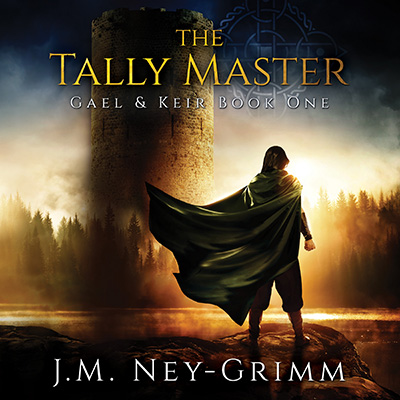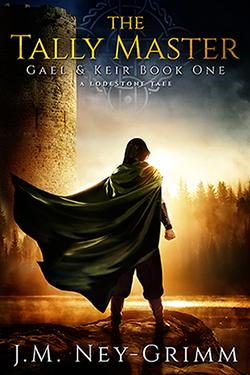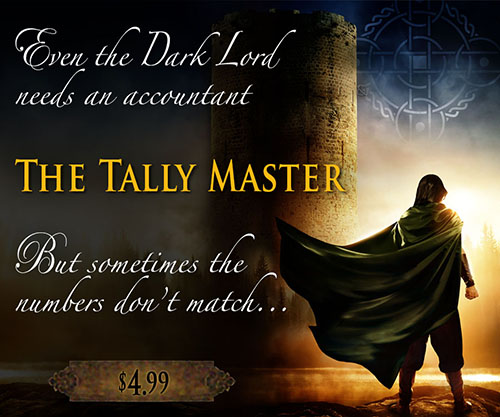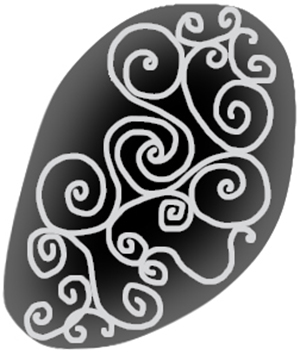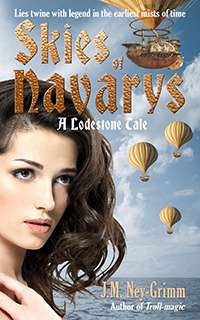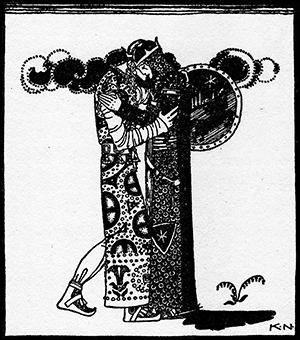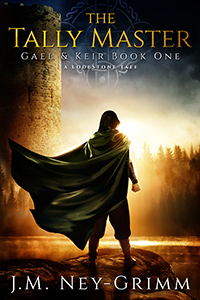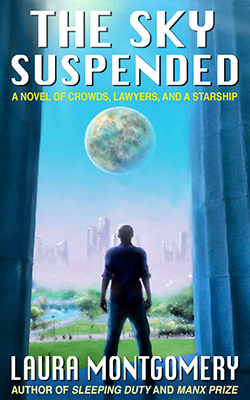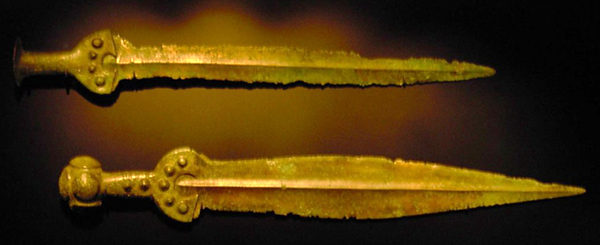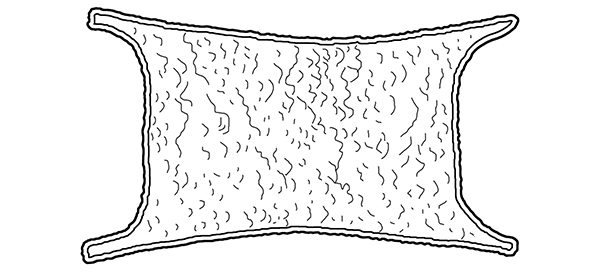
Uh, oh. I made a mistake.
I’ve been sharing my novel The Tally Master as a serial here on my blog, and…I left out a scene! Yikes! How did that happen?
Well, I know how it happened.
Most of the story is told in chapters composed of three or four scenes each. But there are two special scenes that form their own chapters and that have titles instead of “Chapter 1” or “Chapter 2” and so on.
The first of these special scenes occurs between chapters 8 and 9. It tells a North-lands fairy tale that shows the significance of Gael’s name.
So you could read straight from chapter 8 through chapter 9, skipping this fairy tale interlude, and never know that you’d missed anything. That’s just what my serial readers have done! I apologize, guys! I’ve fixed my mistake. The Legend of the Mark of Gaelan is now present in the sequence. New serial readers will encounter it in the proper place.
I’ll share it below in this post as well, so everyone who missed can catch it now. But, gosh, I’m sorry! Forgive me?
What happened is that I put the story up on my blog a chapter at a time. So when it was time to put the next chapter up, I looked to see which one I’d done last. Chapter 8. Okay, 9 comes after 8. So, Chapter 9.
Wrong.
I should have looked at the Table of Contents. That would have shown me that one of the special scenes came next. Lesson learned. Once I get Chapter 19 posted, I will not then post Chapter 20. I’ll post the next special scene!
So why is the significance of Gael’s name important? Because he’s named after a legendary hero who most people in my North-lands revile. Gaelan was the North-lands equivalent of our Earth’s Cain. To learn why, read on… 😀
Legend of the Mark of Gaelan
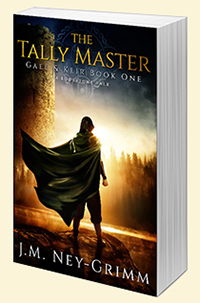 Long ago, in the dawn of time, there lived two brothers in the land of Erynis. They studied magery, and each vied with the other to be the most skillful, the most powerful, and the most creative magus in the north. Despite their rivalry, they loved one another as brothers do: strong affection mingled with equally strong jealousy.
Long ago, in the dawn of time, there lived two brothers in the land of Erynis. They studied magery, and each vied with the other to be the most skillful, the most powerful, and the most creative magus in the north. Despite their rivalry, they loved one another as brothers do: strong affection mingled with equally strong jealousy.
Each boasted that his magery was better. And each laughed, because who was to judge between them?
The friends of Cayim, the elder brother, would surely say he excelled every other magus in the land, while the students taught by Gaelan, the younger brother, would choose their teacher as the best. And all the people of Erynis were either friends of Cayim or students of Gaelan.
Now it chanced that the twin gods of Erynis heard the boasts of the two brothers. Thelor, the god of cleverness and intellect, felt sure that his powers of reason could discern which brother was the more masterful magus. And Elunig, the goddess of wisdom, loved her twin and wished him to experience the enjoyment that exercising discernment would give him.
So, when next the holy hermit of Erynis sat in meditation, Elunig granted him a vision. In his vision, Gaelan and Cayim traveled to the hermit’s shrine and from there were transported to the heavenly home of the twin gods, where they would be judged. The superior brother would be offered the choice between two wondrous gifts.
When Cayim heard of the hermit’s vision, he longed for Thelor’s gift: the enchanting of a well such that the one who drank of its waters would always know whether a given fact be false or true.
And when Gaelan learned of the hermit’s vision, he yearned for Elunig’s gift: the enchanting of a spring such that the one who drank from it would always know whether a proposed action was wise or foolish.
On the eve of midsummer, the two brothers met and agreed to the trial of mastery. They journeyed to the hermit’s shrine and were brought to the twin gods’ home as the hermit’s vision had promised.
They received their welcome in a garden of surpassing beauty. Red poppies crowded the borders. White roses, heavy with scent, climbed the trellises. And a fountain splashed.
Elunig spoke the first words, her voice gentle. “You are safe here, but do not stray into the wilderness beyond the hedge, for it is perilous there.”
Thelor spoke next, his tone stern. “Nor should you leave the chambers to which we bid you in our house, for dangers lurk in unexpected corners.”
Gaelan, overwhelmed by the majesty of the twin gods, bowed reverentially. But Cayim delayed, curious to discover if he could understand more of the divine by scrutinizing these magnificent examples of it. While he stared, and while Elunig gazed affectionately upon Gaelan, Thelor laid a finger aside his nose and winked.
Then a servant brought them goblets of fruit nectar to quaff, and when they had quenched their thirst, led them indoors.
Gaelan bathed his face and hands in the basin provided and lay down upon the silken couch to sleep. But Cayim waited until his brother’s eyes closed and retraced his steps to the garden. There he found Thelor, seated on the steps below the fountain.
“Why did you wink?” Cayim asked.
“I wished to tell you that my sister longs for a babe, despite our great mother declaring that enough divine children have entered the world.”
“Why did you wish to tell me this?” asked Cayim.
“That I shall not tell you,” answered Thelor. And he dismissed the curious brother.
The next day, after they had broken their fast on cream and honey and peaches, the brothers were ushered into a great hall with white marble floors and pillars.
Gaelan performed his magery first. He summoned flame, which transformed to sunlight and then into ice. He built a palace of the ice, which melted to become a mountain lake in which brilliant fishes swam. One fish grew into a dragon, bursting from the surface of the water and soaring to the clouds. The dragon’s scales became rose petals, and the beast came apart in a shower of blossoms, falling through a rainbow.
Elunig clapped in delight when Gaelan finished.
“Beautiful! Beautiful!” she exclaimed.
Cayim’s performance was less elaborate, by far.
He spread a magical carpet of rich blue and green threads on the marble floor. He summoned a rush basket, intricately plaited, to rest upon the carpet. He caused the soft trills of a flute to sound. And then he laid an infant to rest within his nest.
Elunig rushed forward, catching the child in her arms and pressing it to her breast. “Oh!” she cried.
“She is a human child, not a divine one,” said Cayim, “and so I judge that the great mother cannot object. Neither can any human mother, for this child has neither mother nor father nor any kin to care for her. She is yours, if you will have her.”
“Oh!” cried Elunig again.
Thelor smiled. “You envisioned this trial of skill as a gift to me, sister. But now I make it over to you.”
Elunig kissed the babe’s downy head. “Cayim has won my heart, if he has not won your reason, my twin,” she said.
“Then Cayim shall be the master magus,” declared Thelor. And then, forgetting discretion, he winked in full view of both brothers.
Upon seeing Thelor’s wink, Gaelan guessed all that had hitherto been hidden to him. Jealous rage flooded through him, and he lashed out. Had he been arguing with his brother, he might have lashed out with words. Had he been wrestling with Cayim, he would surely have struck with his fists. But because he’d been performing magery, he assailed his brother with the energea of his magery. And because he was full of wrath, his magery lacked his usual control.
His energea cracked out as black lines of force limned with gold. Not blue or silver or green, all safe. But most perilous black and gold.
Cayim fell to the floor, dead.
Within Gaelan, his heart broke—for he loved his brother yet—and his nodes—the source of his energea—tore. So strong was the disruption that Gaelan’s inner damage manifested immediately in his outer form. His ears grew enlarged and cupped. His nose lengthened, curving up. His skin sagged, and his back hunched. His thumbs became crooked and long. The truldemagar claimed him violently.
The twin gods returned Gaelan to Erynis and then did penance for centuries. They had destroyed two worthy men.
Ever after, all who dwelt within Erynis called the truldemagar the mark of Gaelan. In other lands, some who heard the legend of Gaelan adopted that name as well.
And though the righteous hate Gaelan for his fratricide, the merciful grieve for Gaelan’s loss and revile Cayim for his trickery.
* * *
Want to read the serial? See:
The Tally Master, Chapter 1 (scene 1)
Want to know more about Gael’s world? See:
The Dark Tower
Mapping Ancient Rome onto Belzetarn
What Does the Tally Master Tally?
Map of the North-lands in the Bronze Age
Bronze Age Swords
Brother Kings
